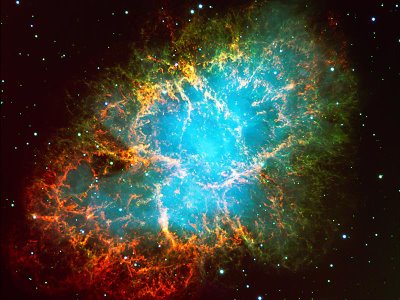Our Marvelous Backyard

(Above: Saturn, as seen by the Cassini spacecraft in October 2004)
Brightly-colored planets with violent, swirling storms big enough to swallow the Earth and mountains as large as Arizona may seem like the products of a creative science fiction writer, but they all exist within our very own solar system. In fact, each object has its own unique features that show the creative freedom God used when forming it.
The Sun - The nearest star to Earth, the Sun maintains a surface temperature of approximately 10,382°F and provides light and heat to the solar system. In fact, it is crucial for the production of oxygen on Earth. With a diameter of 863,705 miles, the Sun comprises 99.8% of the total mass of the solar system, and is more massive than about 90% of the stars in the universe.
Mercury - This charred, heavily-cratered planet has a year lasting only 88 Earth days as it orbits the Sun at a brisk pace of just under 107,000 mph. Due to the lack of any substantial atmosphere daytime temperatures can reach a blistering 806°F, while nights drop down to -292°F. This is the widest temperature range of any planet in the solar system.
Venus - An atmospheric pressure 90 times that of Earth and temperatures reaching as high as 867°F (i.e. hotter than Mercury) provide one of the harshest climates in the solar system, not to mention the constant presence of sulfuric acid clouds hovering overhead. Another interesting note...Venus is the only planet where days are longer than years. There are 243 Earth days between each sunrise. However, the planet needs only 224 Earth days to complete its orbit around the Sun.
Earth - Vast expanses of water and vegetation give Earth its beautiful, vibrant colors. They also keep us alive. In a universe filled with blazing stars and icy bits of rock I'd say the ability to support life is a unique trait, wouldn't you? ;)
Mars - Our small red neighbor is home to the largest mountain in the solar system, Olympus Mons, with a summit of 88,600 feet and a base large enough to cover the state of Arizona. The planet's red appearance is caused by iron (III) oxide...better known to us simply as "rust".

(Above: Jupiter is the solar system's largest planet, 2.5 times more massive than all other planets combined)
Jupiter - The Great Red Spot is this planet's most recognizable feature. This enormous storm is characterized by a mass of violently swirling clouds nearly as big as three Earths. The planet spins on its rotation in rather violent fashion as well, resulting in 9.5-hour days and a bulging equator.
Saturn - A complex system of rings composed of rocks, ice and dust encircle this planet, stretching some 300,000 miles across. Saturn is without doubt the most photogenic of the planets and is also one of the least dense. In fact, Saturn would float in water.
Uranus - The first planet formally discovered with the aid of a telescope, Uranus spins on an axial tilt of 98°, meaning that its polar regions receive more energy from the Sun than its equatorial regions. This results in some of the most unusual seasons in the solar system.

(Above: Neptune's blue color is caused by traces of methane found in its atmosphere)
Neptune - Even though its inner core is hotter than the Sun (12,632°F), temperatures on Neptune's surface dip down to -364°F. However, with winds on the planet reaching 1,500 mph it would actually feel more like -807°F (just for fun, check out the wind chill calculator). Neptune's winds are the strongest in the solar system.
Pluto - Always a planet to me ;) Pluto moves so far from the Sun during part of its orbit that its thin gaseous atmosphere actually solidifies and falls to the ground. The atmosphere is then restored as the planet moves closer to the Sun and the solid surface becomes gaseous. The cycle repeats in perfect balance.




